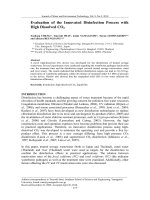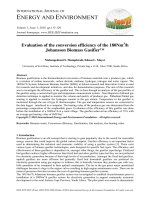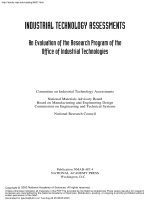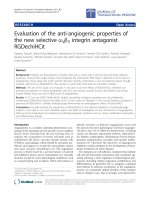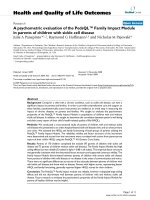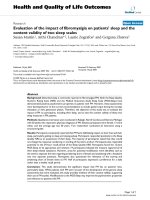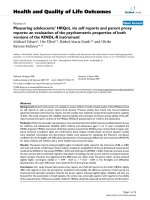Evaluation of the Innovated Disinfection Process with High Dissolved CO2
Bạn đang xem bản rút gọn của tài liệu. Xem và tải ngay bản đầy đủ của tài liệu tại đây (307.19 KB, 8 trang )
Journal of Water and Environment Technology, Vol. 8, No.3, 2010
Address correspondence to Tsuyoshi Imai, Graduate School of Science and Engineering, Yamaguchi
University, Email:
Received December 23, 2009, Accepted April 26, 2010.
- 177 -
Evaluation of the Innovated Disinfection Process with
High Dissolved CO
2
Xuehang CHENG*, Tsuyoshi IMAI*, Junki YAMAGUCHI*, Tawan LIMPIYAKORN**
and Alissara REUNGSANG***
* Graduate School of Science and Engineering, Yamaguchi University, 2-16-1, Tokiwadai,
Ube, Yamaguchi, 755-8611, Japan
** Faculty of Engineering, Chulalongkorn University, Bangkok, 10330, Thailand
*** Faculty of Technology, Khon Kaen University, Khon Kaen, 40002, Thailand
Abstract
A novel high-dissolved CO
2
device was developed for the disinfection of treated sewage
wastewater. Several experiments were conducted regarding the waterborne pathogen inactivation
rate, the treatment time and the disinfection target (several treated sewage wastewaters, canal
and river water). The results indicated that different disinfection targets can lead to 2.8-3.0 log-
inactivation of waterborne pathogens within 20 minutes of treatment under 0.3 MPa of pressure
in the device. Results also showed that the suspended solid (SS) in raw water affected the
disinfection efficiency.
Keywords: disinfection, high dissolved CO
2
, liquid film
INTRODUCTION
Disinfection has become a challenging aspect of water treatment because of the rapid
elevation of health standards and the growing concern for pollution free water resources.
Coagulation-membrane filtration (Fiksdal and Leiknes, 2006), UV radiation (Hijnen et
al., 2006), and ozone associated processes (Rennecker et al., 1999; Jyoti et al., 2004;
Rashmi et al., 2007) have been developed as new disinfection technologies to replace
chlorination disinfection due to its toxic and carcinogenic by-products (Steve, 2009) and
the invalidation of some chlorine-resistant protozoan, such as Cryptosporidium (Kristen
et al., 2000) and Giardia (Lawryshyn and Cairng, 2003). However, the high
construction costs and operation expenses have become problems that prevent their use
in practical applications. Therefore, an innovative disinfection process using high-
dissolved CO
2
was developed to minimize the operating cost and provide a free by-
product effect. This process is a new concept differing from high pressure CO
2
disinfection (Laura et al., 2005) and supercritical CO
2
disinfection (Ishikawa et al.,
1997; Kobayashi et al., 2007; Liao et al., 2007).
In this paper, treated sewage wastewater (both in Japan and Thailand), canal water
(Thailand) and river (Thailand) water were used as targets for the disinfection to
confirm the disinfection effects in practical applications. The relation between
inactivation rates of the fecal coliforms (FC) and total coliforms (TC) (the indicator
waterborne pathogen) as well as the treatment time were examined. Additionally, other
factors affecting the FC and TC inactivation rates were also discussed.
- 178 -
MATERIALS AND METHODS
Disinfection mechanism
The high-dissolved CO
2
device is shown in Fig. 1. To improve the contact efficiency
between CO
2
and water, the nozzle with a small radius was set to provide influent at a
high rate. When the influent stroked the bottom of the device, many liquid films
(bubbles) were produced, and as a result, the CO
2
dissolution rate increased because of
the larger gas-liquid contact area.
Inside the device, the microorganism uptake the CO
2
dissolved in the water because of
the existence of the CO
2
concentration difference between the inside (low) and outside
(high) of the cell. When the water was discharged outside the device, the pressure
suddenly decreased, while the CO
2
inside the cell appeared and caused a large amount
of bubbles quickly, resulting in a rupture of the microorganism. Additionally, the CO
2
penetrating into the microorganism was able to alter the properties of the cells (Dixon
and Kell, 1989). Therefore, disinfection in this study can be defined as microorganism
inactivation.
Fig. 1 - Mechanism of the high-dissolved CO
2
device
Disinfection experiment
The effluent from the final settling tank of a wastewater treatment plant (WWTP) as
well as canal water and river water were used as targets for disinfection in this study.
During this study, one set of operational conditions was applied for the device, as shown
in Fig. 2. CO
2
was filled the device before the experiment; the water cycled in 20 min
after it was pumped into the device; and the samples were taken at different times.
Analytical procedures
Enumeration of bacteria was done by plate count method as recommended by
Japan
Sewage Works Association (JSWA, 1997). This method of analysis has been used for
the estimation of the overall reduction in the colony forming units (CFU). For this
purpose, desoxycholate agar was used as the growth medium. The samples before and
after treatment suitably diluted was introduced into each Petri dish first and then 10 mL
of media was added and mixed, after they turned into solid, another 10mL of media was
added. For FC count, these Petri dishes were inverted and incubated at 44.5°C for 18-20
- 179 -
h; For TC count, these Petri dishes were inverted and incubated at 37°C for 18-20 h. The
colonies developed were counted and expressed as CFU/mL. The data presented are the
means with standard errors of the results of experiments performed in several sessions
The log survival ratio (log
10
(N/N
0
)) was calculated to determine the final inactivation
effect, where N
0
was the number of initial microorganisms in the untreated sample, and
N was the corresponding viable number of microorganisms after treatment. Suspended
solid (SS) and volatile suspended solid (VSS) were analyzed by Standard methods for
water and wastewater analysis (APHA, 1989), TOC was analyzed by TOC-5000
(SHIMADZU, Japan).
Fig. 2 - Device operating conditions
RESULT AND DISCUSSION
Optimization of operating conditions
The effluent from the final settling tank of a WWTP (Ube City, Japan) used as the target
for disinfection was treated under different pressures. The experiment was repeated for
two months. The average results are shown in Fig. 3 and show that TC only achieved a
1.2 log-inactivation under 0.2 MPa of pressure for 20 min. However, a 2.0 log-
inactivation of TC occurred quickly under 0.5 MPa and 0.4 MPa of pressure in 10 min.
Additionally, under 0.3 MPa of pressure, TC log-inactivation reached 2.7-3.0. Therefore,
the operational condition of 0.3 MPa for 20 min was selected because the lowest
pressure achieved the highest TC log-inactivation. Also, compared to the supercritical
CO
2
method, which requires pressures as high as 8-20 MPa (Ishikawa et al., 1995), this
method saved lots of energy. In addition, when compared to the high pressure process
for disinfection, which requires a long duration of pressure leading to the deformation of
the cell (Laura et al., 2005), the method used in this study saved operation time.
- 180 -
Fig. 3 - Inactivation of TC under different inside pressures in the device. (Each data
point is an average of independent experiment and error bars represent the
data range.)
Disinfection effect of different initial FC
Experiments were conducted at least twice, with several effluents from the final settling
tank of the WWTP (Table 1), at the operational condition of 0.3 MPa of pressure.
WWTP1 had a FC log-inactivation as high as 1.5 in 10 min. However, it took time for
the other two samples to increase the FC log-inactivation in 10 min, but after 10 min,
the FC log-inactivation quickly increased. The reason for these results is that these two
samples had more initial FC numbers, and 10 min was not long enough for all of the
bacteria to uptake enough CO
2
, which lead to the explosion of all cells when discharged
outside of the device. Based on these results, we speculated that lower initial microbial
numbers could quickly achieve high disinfection effects.
Table 1 - Water quality of different WWTP final settling tank effluents in Thailand
Place SS (mg/L) VSS (mg/L) TOC (mg/L) FC (CFU/mL) Sample
Din Deang WWTP 3.41 2.38 5.52 940±20 WWTP1
Si phraya WWTP 5.36 4.64 5.11 1300±45 WWTP2
Chong Nonsi WWTP 5.73 3.08 6.86 2400±120 WWTP3
- 181 -
Fig. 4 - Inactivation of FC from different WWTP final settling tank effluents. (Each
data point is an average of independent experiment and error bars represent
the data range.)
Disinfection effect of different suspended solids concentrations in raw water
As shown in Fig. 5, canal water 1 and the river water (Table 2) shared lower initial FC
numbers compared to the WWTP samples, but the FC log-inactivation was lower than
0.4 in the first 10 min, then quickly increased after 10 min. One reason for this result
could be that the higher SS in the canal and river waters inhibited the uptake of CO
2
by
the bacteria, leading to the slower FC inactivation. The results also revealed that it was
possible to reach a high FC log-inactivation of 2.8 for the canal and river waters in 20
min. Canal water 2 contained a very high initial FC number, and the FC log-inactivation
was relatively flat due to the high initial FC number that inhibited the effects of the SS.
Table 2 - Water quality of different canal and river water in Thailand
Place SS
(mg/L)
VSS (mg/L) TOC (mg/L) FC (CFU/mL) Sample
Pathuntani Klong 5 11.6 2.26 9.55 72±8 Canal
water 1
Khlong Phadung Krung
Kaseme
33.6 13.4 13.0 35000±550 Canal
water 2
Chao Phraya River
(Largest river in
Bangkok)
17.7 2.08 7.73 690±30 River water
